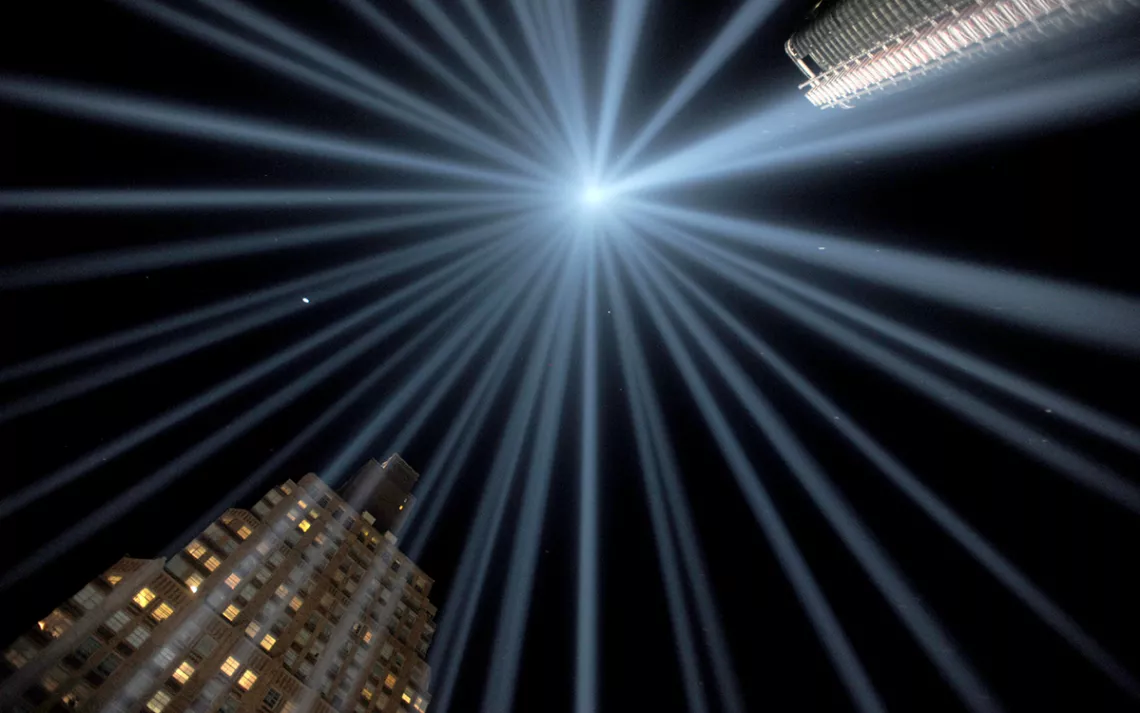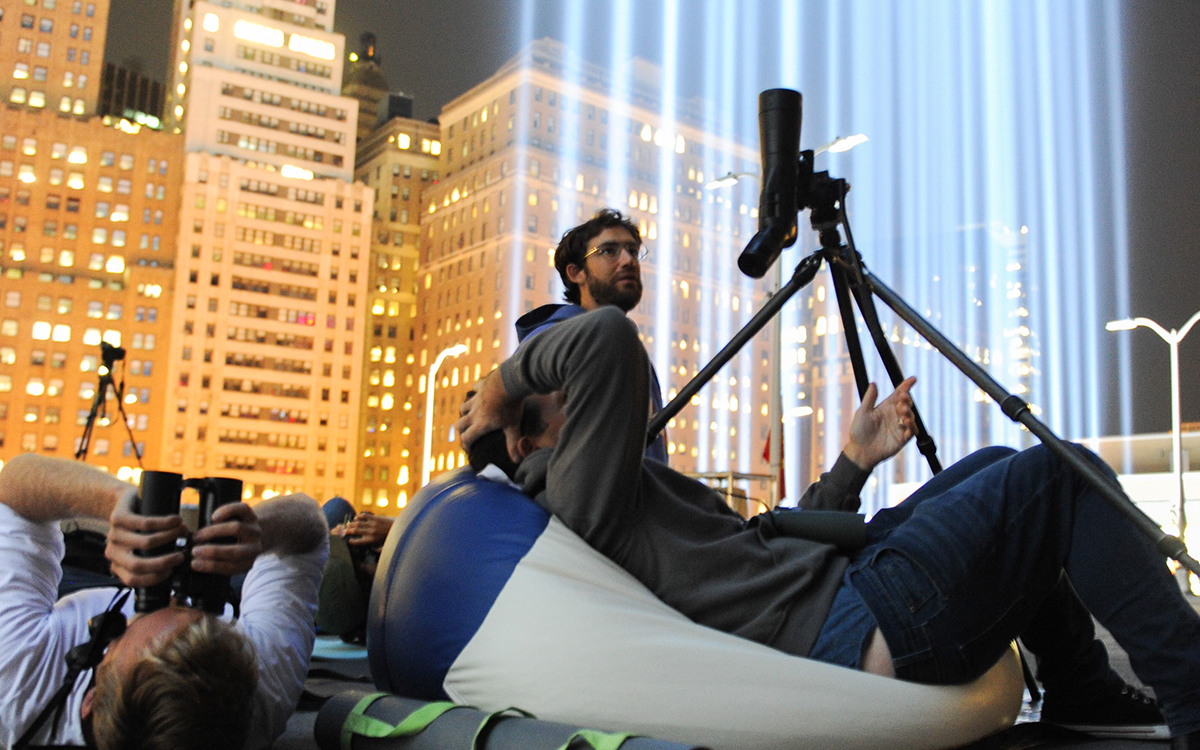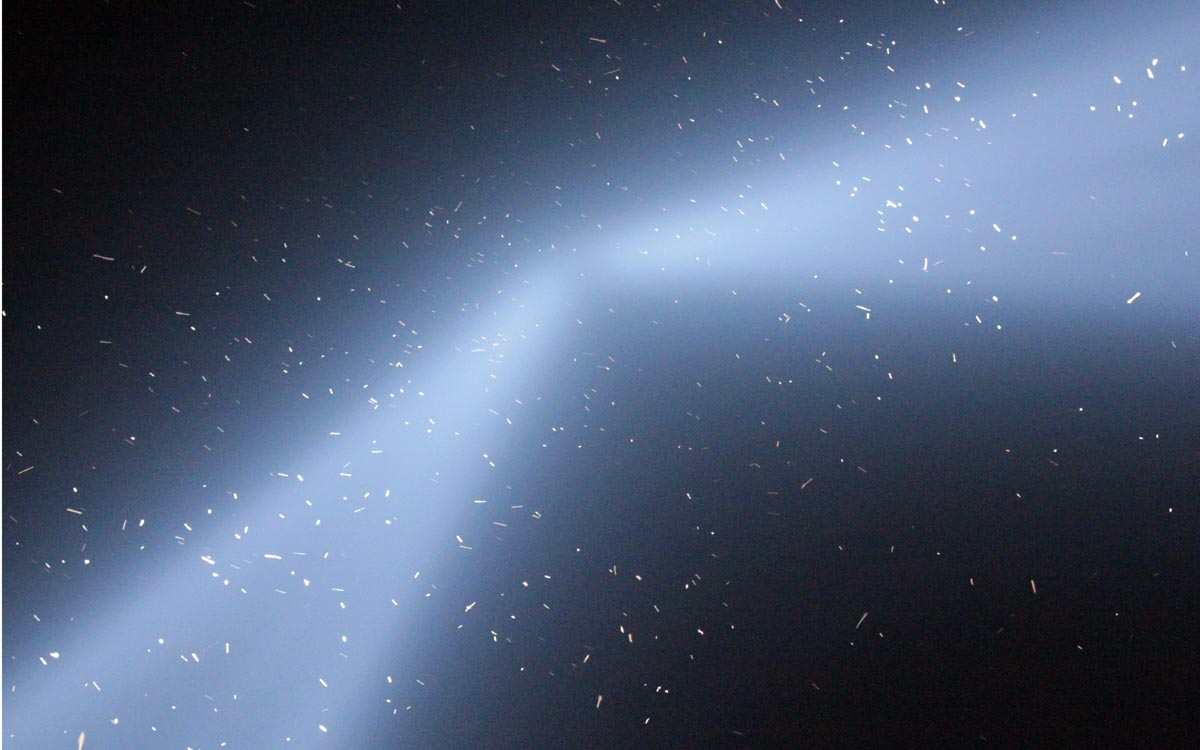The Birds, the Scientists, and the 9/11 Memorial
The research happening at Tribute in Light

Photograph by Dennis Van Tine | AP
“At first, we were not welcomed with open arms,” remembers Susan Elbin, conservation scientist emerita with NYC Audubon.
At dusk every September 11, two massive columns of light honoring those who died as a result of the attacks on the World Trade Center switch on. Near the spotlights, on the roof of the Battery Parking Garage in Lower Manhattan, a small crew of bird monitors from NYC Audubon lie on sleeping mats, looking up at the night sky.

Bird monitors | Photograph courtesy of Sean Sime
When Tribute in Light first appeared, in September 2002, anyone with passing familiarity with birds knew that it was a potential bird disaster. Continuous, bright, white light is the most dangerous kind for birds (that’s one reason why the lights on radio and cell towers are colored and blink on and off). Artificial light interferes with cues birds use to navigate the night sky. It’s well known that birds migrating at night are attracted to and disoriented by certain kinds of light, to the point where some will fly around the beams in circles until they drop from exhaustion or land nearby. Hundreds of years ago, lighthouse keepers noted that some mornings they would wake up to find the corpses of hundreds of birds on the rocks nearby.
But Tribute in Light was also an opportunity. No scientific paper had ever used data and direct observation to quantify the effects of artificial direct light, like the lights used in Tribute, on seasonal migration. Because Tribute had agreed to turn off the lights if too many birds were in danger, NYC Audubon and scientists like Elbin and Andrew Farnsworth, a senior bird migration ecologist at Cornell, have had the opportunity to track, year after year, through different weather, the difference in effects on migratory birds when the lights were off, versus when the lights were on. The research could be used to change how future light installations, like the ones around stadiums, are designed.
Migratory birds fleeing the North American winter for Central and South America begin appearing in New York in mid-August. They increase in number through September, peak around mid-October, and are usually gone by the end of November. The migration is one reason why birdwatching in New York City is so rewarding, compared with other parts of the country—the bright lights of the city draw birds, who then shelter in city parks and green spaces at unusually high densities.
“I started birding after I moved to New York City,” says Kaitlyn Parkins, a senior conservation biologist with NYC Audubon. “I feel like it ruined it a little—I’m used to being able to go to Central Park and see 25 different species of warbler within a 20-minute walking distance. It's really fun for birders. But now that I know what I know, it's concerning for me, because these birds are living on the edge of what is physiologically possible.” If the birds can rest, eat some insects, gain some weight, and not collide with any office buildings, they'll be able to continue on to their destination.
Every migration season is a little different, depending on weather and wind speed and a host of other variables. Right now, the common yellowthroat is passing through, on its way to South America and the West Indies, and the black-and-white warbler, one of the earliest to show up every year, is passing through on its way to Florida and Central and South America. The black-and-white warbler is one of Parkins’s favorites, because it likes to poke around on tree trunks at eye level, looking for insects, which makes it easy to spot.
Because the Anthropocene is a tough time for birds, Parkins knows that migration has begun when people start dropping off dead birds at the NYC Audubon office. “We’ve seen a lot of black-and-white warbler collisions this year,” she says, sadly. There’s usually several hundred collected by the end of the season, which get donated to museums and scientific researchers.
Before the pandemic, anyone who found a dead bird could wander in anytime and deposit it in the society freezer. Now, they need to do so at specific times, or just upload the information to the D-Bird database). Monitors walk the streets of different neighborhoods, on preset routes, every day early in the morning during migration season, looking for the corpses of birds that have collided with windows, in the hopes of establishing patterns and seeing if particular buildings are more dangerous to birds than others. Artificial light at night attracts the birds, but the reflection of sky or a tree in the window of an office building can finish them off. For three years, monitors patrolled a specific route around the site of the World Trade Center to see if there was an increase in dead birds on the streets in the days after Tribute in Light, but they found no evidence of a correlation.
What they have found evidence for is that turning off the lights, even for 20 minutes at a time, actually does a lot to help birds continue their migration. A paper published in PNAS by Susan Elbin, Andrew Farnsworth, and several other scientists found that over a period of seven years monitoring Tribute in Light, the lights had a tremendous effect on birds—the density of birds in air around Tribute increased 20-fold when the lights were turned on, from 500 within a half kilometer when the lights were off to as much as 15,700 birds within the same distance when the lights were on. But once the lights were switched off, the birds dispersed in a matter of minutes.
It was complicated first to get the lights switched off, says Elbin. It’s not an easy thing to accept that a memorial meant to honor the dead and comfort the living could be causing more deaths. Each party—the NYC Audubon monitors and the lighting techs—had to work through their respective chains of command in order to flip the switches. Elbin remembers a lighting tech telling her that each time the lights were switched off, it reduced the life of a very expensive lightbulb, as though the birds passing overhead were comparatively unimportant. But then on one night, Michael Ahern, the producer behind the Tribute lights, saw a bird in distress. He told Elbin, “Whenever you need to turn off the lights, just tell me,” and the levels of bureaucracy fell away. “Since around 2010, says Elbin, “the people working the lights were as concerned about the birds as we were.”
Elbin credits the thaw between groups to the scientific work they were doing—rather than just telling the people the lights were risky for birds, they were collecting data and quantifying the effects. But she also thinks that respect and communication played a not-inconsiderable role. The monitors worked to keep their numbers small, to stay quiet, and to generally behave in a way that would be considered appropriate at a memorial. “Often the families of people who died in 9/11 will come up to the roof the night of,” says Parkins. “Sometimes they come and talk to us about the birds. And we talk to them about the birds. And you can just see how important this installation is to them.”

Birds, bats, and insects drawn to the lights | Photograph courtesy of Debra Kriensky
Every year, the migration is different. Sometimes the weather is balmy, and the monitors are up there in shorts and T-shirts. Sometimes it’s so cold that everyone is wearing gloves and hats. Sometimes the wind comes in strong from the east and blows the birds over to New Jersey, or comes in strong from the north and pushes the birds south before they have a chance to get trapped. Other times, the wind blows in such a way that the migratory flocks are concentrated over Manhattan. Sometimes the cloud cover hangs low, causing birds to fly at an altitude that makes them more likely to get dazzled by the beams.
Sometimes a peregrine falcon appears and hunts the birds trapped by the beam. The monitor will make a note of that. A small crew, led by Farnsworth, sets up microphones and listens for the calls of different species. They study the local weather radar for where the birds are that evening. On radar, a flock of birds looks like rain.
Every 20 minutes, the monitors take a photograph of the sky above them and count the number of birds they see in the beams of light. When a monitor counts more than 1,000 birds trapped in the beam for more than 20 minutes, then the lights switch off. Very rarely, a bird will drop from the sky. When that happens, the lights go out. Sometimes the birds start flying so low that the monitors hear them get louder and louder, and the lights switch off. The 88 xenon bulbs are flipped off, one by one, and the birds continue on their journey.
 The Magazine of The Sierra Club
The Magazine of The Sierra Club



